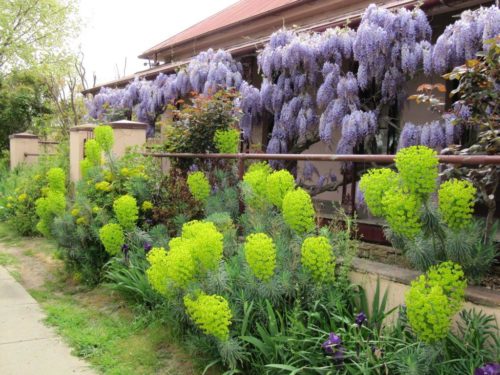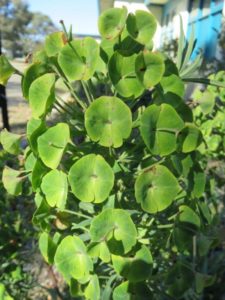
One of gardening writer CEDRIC BRYANT’s favourites is the euphorbia family. And it’s a big family with more than 2000 members!
ONE of my favourite plants is the euphorbia family. Just look at this amazing display of Euphorbia wulfenii or Spurge, with its bright-yellow flowers growing alongside wisteria in an historic home in Yass.

It is just one of more than 2000 members of this family, being one of the largest genera of the plant kingdom.
Euphorbias grow in almost every part of the world. We are all familiar with E. pulcherrima (poinsettia), so popular for Christmas decoration with its deep-red bracts.
Unlike poinsettias, the evergreen, perennial euphorbia is hardy in hot and cold weather. However, one of the problems with E. wulfenii is that it seeds prolifically and can be a menace in the garden.
But don’t be put off from growing these super plants as many new cultivars have been bred in recent times with Plant Growers of Victoria leading the way. Theirs are sterile, don’t produce seed and can be planted with confidence.

Different varieties provide interest in the garden at different times of the year.
A favourite, of which I have recently increased the number in our garden, is Ascot Rainbow with its variegated leaves and yellow flowers growing to 50cm x 50cm. Possibly even more attractive is Rudolf. No guessing why this name with its red-centred leaves in winter followed by tiny red flowers in spring.
Silver Swan has white-tipped silver leaves with cream flowers though winter into spring. It is slightly higher at 70cm tall x 75cm spread.
Blackbird is a compact variety with rich burgundy leaves and yellow flowers in winter to spring; to just 40cm high and 50cm wide. Then there’s Cherokee, an even more compact plant with a mass of tiny yellow flowers from spring through summer. Grow this in conjunction with Sedum Autumn Joy to give a continuation of flowers from late summer to winter.
Tiny Tim is absolutely perfect as a container plant for a sunny balcony. Its tight, mounded habit produces green flower spikes in early spring.
One word of caution, the sap of all Euphorbia can cause skin problems, so wear gloves at all times when handling them.
IT’S amazing the number of females named after plants – Iris, Daphne, and who could forget Hyacinth of the BBC comedy show, Rose and Rosemary.
Rosmarinus officinalis, or “ros marinus” from the classical Latin meaning “the dew of the sea” is a native to the Mediterranean region.
It’s drought resistant and has been used for thousands of years. The ancient Greeks, Romans and Egyptians all considered it sacred.
To us, it’s a symbol of remembrance for war commemorations such as Anzac and Remembrance Day. The soldiers having seen it growing wild in flower on the heights of Gallipoli.
The ancients used it for body perfume, in the embalming process of mummies, as incense and even today for shampoos and soaps.
It is still used in numerous culinary ways, particularly as a stuffing for various roast meats. Its leaves can be used as a tea.
Its blue flowers and small growth make it ideal as a low hedge bordering a driveway or path.
While many may consider this plant as rather common, it’s one of the most useful plants in any garden or in pots on a balcony. There are numerous cultivars of which Blue Lagoon is one of the most popular with its intense blue flowers. Although for culinary purposes I recommend Chef’s Choice.
Who can be trusted?
In a world of spin and confusion, there’s never been a more important time to support independent journalism in Canberra.
If you trust our work online and want to enforce the power of independent voices, I invite you to make a small contribution.
Every dollar of support is invested back into our journalism to help keep citynews.com.au strong and free.
Thank you,
Ian Meikle, editor




Leave a Reply